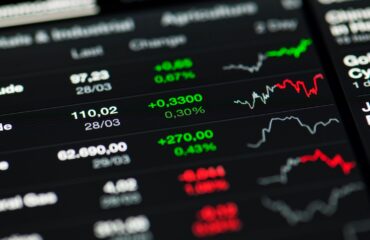If one were to consider the saga of last week, the presence of a characteristic ‘mixed bag’ in the US market would be undeniably prominent. What we witnessed, dear reader, is the ebbs and flows of market currents, stirred by factors as diverse as Apple Inc.’s erasure of gains and allegations against Binance Holdings Ltd.
One might recall the brimming confidence of the bull, bolstered by the promise of Big Tech and the whispers of a pause in interest rate hikes. The S&P 500, our emblematic barometer of American equities, had been poised on the brink of entering its official ‘bull market’ territory, sitting pretty at a mark that was 20% above the lows seen in October. But alas, the volatile dance of the markets – though I hesitate to liken this intricate entanglement of economic forces to anything so leisurely as a dance – meant that these hopes were dashed. A subtle but sudden retrenchment of 0.3% plunged the S&P 500 from the precipice of triumph to the dull plains of hesitation.
Moreover, tech stocks that had once seemed like the market’s leading luminaries suddenly dimmed. The erstwhile darling of Wall Street, Apple Inc., found itself receding from the limelight, casting a pall on the NASDAQ Composite, which had been similarly buoyed by Big Tech’s promises. The announcement of a forthcoming mixed-reality headset seemed to stoke little investor enthusiasm, serving to underscore the market’s increasingly skeptical view of technology’s glittering allure.
In tandem, the energy sector felt the tremors. Oil giants Chevron Corp. and Exxon Mobil Corp., after initially surfing the wave of Saudi Arabia’s oil supply cut, found themselves capsizing. The resulting turbulence left ripples on the S&P 500, emphasizing the interconnectedness of these different spheres of market influence. Yet, the oil majors’ fall was not the lone agent stirring waters. The Institute for Supply Management’s overall gauge of services provided an unexpected shock as it slumped to its lowest level for the year. This gloomy report did little to brighten the picture being painted of the US economy, leaving its protagonists and observers alike with a sense of unease.
A similar mood of contemplation is palpable among the economic analysts. Andrew Hunter of Capital Economics noted the contrast between the relatively optimistic narrative spun by S&P Global PMIs and the more pessimistic tale being told by ISM surveys. The latter’s seeming anomaly may not be so anomalous after all. If we collate these disparate data points, taking into account regional Fed activity surveys and other hard data, we might find GDP growth teetering on the brink of the positive zone for Q2.
Such observations give credence to Saira Malik’s view that a mild recession may be knocking on our door by 2024, courtesy of the “growth-dampening effects of tight monetary policy”. Against this backdrop, real assets are becoming a beacon for investors looking for some semblance of inflation protection. And among such real assets, farmland gets a special mention.
Yet, despite these whispers of future strife, Bitcoin and Ether, the standard-bearers of the cryptocurrency world, both slumped. The crypto realm is indeed caught in a whirlwind of its own, with Binance Holdings Ltd., one of its high-profile entities, finding itself in the eye of the storm. Accusations of transgressing US securities rules against the company and its CEO are acting as a chilling headwind, reminding crypto enthusiasts of the regulatory hurdles that lie ahead.
In parallel, corporate maneuverings are also influencing the market landscape. Safran SA, an aerospace multinational corporation, is rumored to be eyeing an acquisition deal with Raytheon Technologies Corp., valuing the business at a cool $1 billion. The maneuver, while promising, adds to the turbulence in the market, evincing the capricious nature of corporate interests and their potential impact on the broader market.
In other news, the Janssen unit of Johnson & Johnson has requested a withdrawal of the emergency authorization for its Covid-19 vaccine. This unexpected development added a pinch of uncertainty to the health care sector, further roiling the markets.
Concurrently, the international scene, too, presented a kaleidoscope of market movements. While European equities floundered, Asian indexes, with some notable exceptions, edged upwards. The Nikkei 225, a beacon of Japanese equities, climbed by a healthy 2.2%, achieving its highest level since 1990. The prospect of a weak yen bolstering corporate profits seemed to have lured investors towards it.
On the currency front, the dollar showed signs of wilting against its peers. Meanwhile, gold glittered a little brighter, gaining by 0.4% – a reassuringly stable performance in a marketplace characterized by change. This reflected the enduring appeal of the precious metal as a safe haven in times of uncertainty.
In a marketplace where the only constant seems to be change, various key events loomed on the horizon this week. Rate decisions in Australia and Poland on Tuesday set the stage, followed by a flurry of updates from China, the US, and Canada. Perhaps the most eagerly awaited figures were from China’s forex reserves and trade data, along with the US trade and consumer credit numbers.
Casting our eyes further ahead, Thursday brought with it decisions on interest rates from India and Peru, along with the unveiling of Japan’s GDP data. These key developments, along with updates on US wholesale inventories and initial jobless claims, promised to shape the markets’ narrative in significant ways.
On Friday, the curtain fell with China’s PPI and CPI data, promising to either confirm or contradict prevailing market sentiments. These pieces of data were watched closely by investors and analysts alike, serving as the capstone to a week marked by fluctuating market forces and varied investor sentiment.
Reflecting on the bond market, the yield on 10-year Treasuries remained relatively unmoved at 3.69%, while Germany’s 10-year yield advanced seven basis points to 2.38%, and Britain’s 10-year yield advanced five basis points to 4.21%. Despite the tremors shaking other sectors, the bond market seemed to have taken on the mantle of a stoic observer, subtly reflecting the undercurrents of macroeconomic forces at play.
Meanwhile, the West Texas Intermediate crude oil continued its march, rising 0.4% to $72.01 a barrel, illustrating that even in a mixed market scenario, there exist pockets of resilience and growth.
In sum, the week has been characterized by a tempering of exuberance, as optimism around the Big Tech rally and expectations of a pause in interest rate hikes gave way to the realization of risks associated with a potentially tepid economy and regulatory pitfalls. As we look forward, the market appears to be bracing itself for the possible advent of a mild recession, while simultaneously seeking solace in real assets and farmland. A complex interplay of factors continues to define the market’s narrative, serving as a potent reminder of the constant evolution and intricate dynamism of financial markets.



